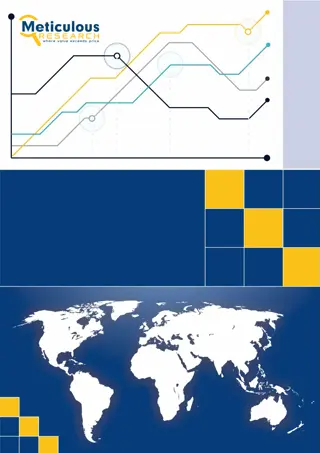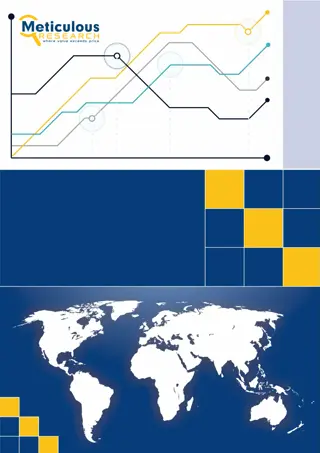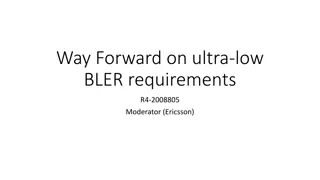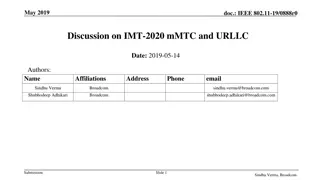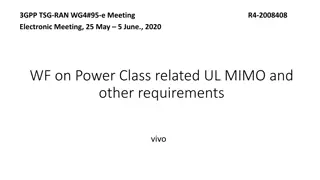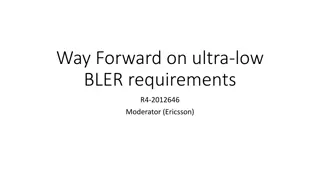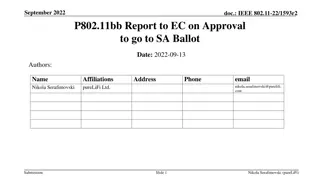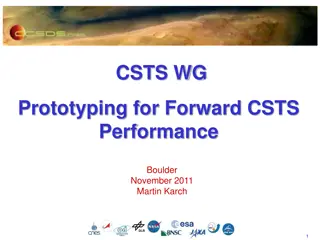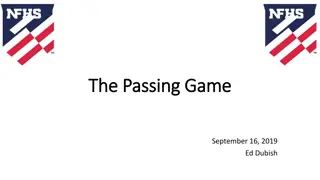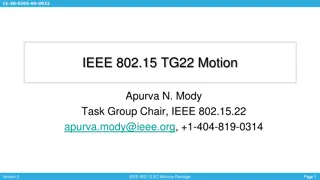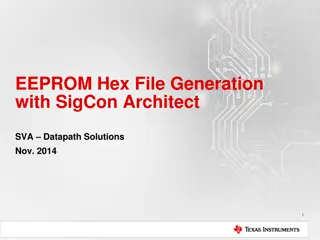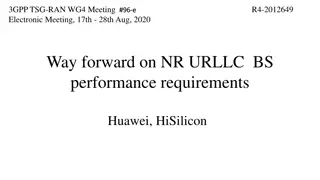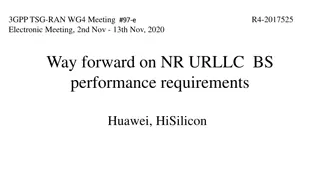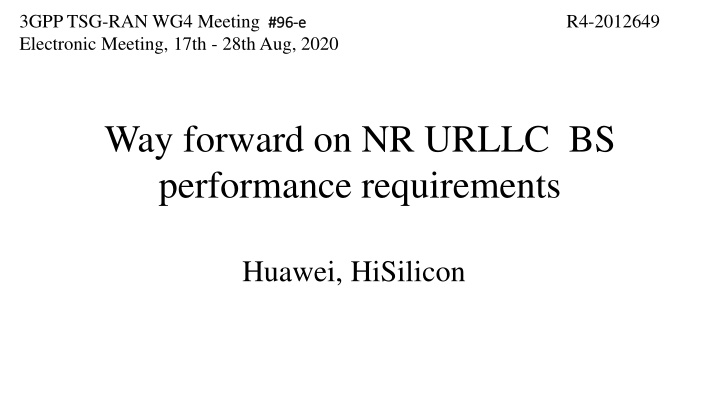
NR URLLC BS Performance Requirements and Demodulation Agreements
Explore the latest approved work items and agreements from the 3GPP TSG-RAN WG4 Meeting #96 regarding NR URLLC demodulation requirements, high reliability agreements, and BS performance. Get insights into the applicability rules for FDD and TDD, antenna configurations, test metrics, and more for efficient BS demodulation in 5G NR networks.
Download Presentation

Please find below an Image/Link to download the presentation.
The content on the website is provided AS IS for your information and personal use only. It may not be sold, licensed, or shared on other websites without obtaining consent from the author. If you encounter any issues during the download, it is possible that the publisher has removed the file from their server.
You are allowed to download the files provided on this website for personal or commercial use, subject to the condition that they are used lawfully. All files are the property of their respective owners.
The content on the website is provided AS IS for your information and personal use only. It may not be sold, licensed, or shared on other websites without obtaining consent from the author.
E N D
Presentation Transcript
3GPP TSG-RAN WG4 Meeting #96 Electronic Meeting, 17th - 28th Aug, 2020 R4-2012649 #96- -e e Way forward on NR URLLC BS performance requirements Huawei, HiSilicon
Background The following WFs were approved: R4-1915913: Way forward on NR URLLC demodulation and CSI requirements, RAN4 #93 R4-2002429: Way forward for NR BS URLLC performance requirements, RAN4 #94-e R4-2005528: Way forward for NR BS URLLC performance requirements, RAN4 #94bis-e R4-2008810: Way forward for NR BS URLLC performance requirements, RAN4 #95-e
PUSCH PUSCH BS BS demodulation requirements of high demodulation requirements of high reliability: reliability: Agreements: BS demodulation requirements of high reliability for FR1 PUSCH aggregation factor for TDD 15 kHz SCS with pattern DDDSU: Configure n2 for FDD and n8 for TDD with note. Note: The intention of this configuration is to have two effective transmissions of the transport block. To achieve this for the standard TDD pattern captured in this table, a value of n8 is necessary, while for FDD a value of n2 is necessary. BS demodulation requirements of high reliability for FR2 Test applicability rule for FR2 for different SCS: Only 1 SCS need to be tested Test applicability rule for FR1 and FR2: If BS declare to support both FR1 and FR2, the tests shall be done both. Antenna configuration: 1x2, ULA low SCS/BW for FR2: 60 kHz/50MHz, 120 kHz/ 50MHz Mapping type: Type B MCS: MCS5 from table 3 Start symbol: 0 Symbol length: 10 DM-RS Type: Type 1 DM-RS duration: Single-symbol DM-RS Bandwidth allocation: Full bandwidth Maximum number of HARQ re-transmissions: 4 Test metric: 1% BLER (Calculated after all re-transmissions)
BS BS demodulation requirements of high reliability for FR1 demodulation requirements of high reliability for FR1: : Applicability rule for FDD and TDD Option 1: The requirement with PUSCH aggregation level n8 for TDD with 15 KHz SCS can be applied with FDD or TDD 30 KHz SCS with PUSCH aggregation level n2. Option 2: The requirements for PUSCH with aggregation for 15kHz can be tested either by configuring n8 and the DDDSU TDD pattern or by configuring FDD with aggregation level n2. RV sequence with 4 HARQ transmission Option 1: 0 3 0 3 under full buffer scenario. Option 2: Effective RV sequence with 4 HARQ transmission: {0 2 3 1} Whether to clarify the safety statement Option 1: No need to specify any safety statements in specification Option 2: Yes Option 1a: Since the URLLC features of 5G NR will potentially be used in safety critical applications, the ultimately chosen statistical testing methodology for testing of these features must be verified by an independent body of experts/statisticians, before requirements and test can be used as basis for safety critical implementations. All statistical analysis and discussions provided in this meeting are to be taken as a best effort and is not to be taken as due diligence Option 1b: If the URLLC features of 5G NR would be used in safety or mission critical applications, the ultimately chosen statistical testing methodology for testing of these features must be verified by an independent body of experts/statisticians. It is also important to bear in mind that the demodulation requirements do not take account of all aspects of system operation (for example RF, transmitter, internal interfaces, higher layer protocol software etc.).
BS BS demodulation requirements of high reliability for FR2 demodulation requirements of high reliability for FR2: : TDD pattern Option 1: DDDSU, S=10:2:2 Option 2: DSUU, S=12:2 Aggregation factor for TDD Option 1: n8 for DDDSU Option 2: n2 for DSUU Option 3: n8 for DDDSU with note Note: The testing can be performed with a different TDD pattern Channel model Option 1: TDLA30-300 Low Option 2: TDLA30-75 DM-RS Option 1: 1+0 and 1+1. Option 2: 1+1
Simulation assumptions for PUSCH demodulation Simulation assumptions for PUSCH demodulation requirements for high reliability with higher BLER and/or confidence reliability with higher BLER and/or confidence level Parameter Frequency range Transform precoding Antenna configuration Mapping type Starting symbol (S) Length (L) requirements for high level for FR1 for FR1 Value FR1 Disabled 1x2, ULA Low Type A and Type B 0 14 n2 for 30 kHz SCS n2 for FDD and n8 for TDD[note 1] Type 1 Single-symbol DM-RS PUSCH configuration PUSCH aggregation factor DMRS Type DM-RS duration Number of additional DMRS PUSCH DMRS configuration 1 Propagation condition MCS Table TDLB100-400 Table 3, MCS 5 15 kHz for 5/10 MHz 30 kHz for 10/40 MHz Full Bandwidth 15 kHz SCS: 3D1S1U, S=10:2:2 30 kHz SCS: 7D1S2U, S=6:4:4 4 Target BLER: 10-2 (Calculate the target BLER after all transmission) SCS and BW Frequency domain resource TDD pattern Maximum number of HARQ transmissions Testing metric Note 1: The intention of this configuration is to have two effective transmissions of the transport block. To achieve this for the standard TDD pattern captured in this table, a value of n8 is necessary, while for FDD a value of n2 is necessary.
PUSCH PUSCH demodulation requirements for low demodulation requirements for low latency for FR2 latency for FR2 BS FR2 URLLC demodulation requirements for PUSCH mapping Type B Agreements: Test applicability rule for FR1 and FR2 if both are supported by BS: Tests shall be done for both, and only 1 SCS will be tested for each frequency band with test applicability rule. SCS/CBW for FR2: 60kHz/50 MHz, 120 kHz/ 50 MHz TDD pattern: DDDSU, S=10:2:2 Aggregation factor for TDD: n1 Channel model TDLA30-300 Antenna configuration 1x2, ULA low Bandwidth allocation Full bandwidth Maximum number of HARQ re-transmissions: 1 DM-RS Type: Type 1 DM-RS duration: Single-symbol DM-RS Start symbol: 0 Test metric: 70% TP Section numbers and title for TS38.104: (TS 38.141-1/2 will follow the agreements.) 8.2.6 Requirements for PUSCH 0.001% BLER 8.2.7 Requirements for PUSCH repetition Type A 8.2.8 Requirements for PUSCH mapping Type B with non-slot transmission FRC numbers in Annex A for TS38.104: (TS38.141-1 and TS38.141-2 will follow the agreements.) A.3A Fixed Reference Channels for performance requirements (QPSK, R=99/1024) A.3B Fixed Reference Channels for performance requirements (QPSK, R=308/1024)
PUSCH PUSCH demodulation requirements for low demodulation requirements for low latency for FR2 latency for FR2 BS FR2 URLLC demodulation requirements for PUSCH mapping Type B MCS Option 1: MCS10 from table 3 Option 2: MCS 5 or MCS 2 from table 3 DM-RS Option 1: 1+0 and 1+1. Option 2: 1+0 Option 3: 1+1 if symbol length larger than 4 Symbol length Option 1: 2 Option 2: 4 Option 3: 7
Rel Rel- -16 URLLC BS features 16 URLLC BS features Features need to be discussed PUSCH repetition type B Inter-UE multiplexing Other features not precluded. Whether to define performance requirements for PUSCH repetition type B Option 1: Yes Option 2: No Whether to define performance requirements for Inter-UE multiplexing Option 1: Yes Option 2: No
PUSCH PUSCH demodulation requirements demodulation requirements CR work split CR work split Specifacation Requirements title CR Specifacation Frequency range CR work CR Responsibility BS demodulation (38.104/38.141- 1/38.141-2) FRC for all test cases 38.104 FR1 FRC Nokia FR2 FFS Samsung 38.141-1 FR1 FRC Ericsson 38.141-2 FR1 FRC Huawei FR2 FRC Samsung Test methodology 38.104? N/A Test methodology Nokia 38.141-1 N/A Test methodology Ericsson 38.141-2 N/A Test methodology Nokia/Huawei Test applicabilityfor all test cases 38.141-1 FR1 Test applicability Huawei 38.141-2 FR1 Test applicability Ericsson FR2 Test applicability Ericsson Requirements for PUSCH with ultra-lowBLER target (10-5) 38.104 FR1 Requirements Nokia FR2 FFS Samsung 38.141-1 FR1 Requirements/Measurement requirements Annex C.3 / Measurement system set-up Annex D of Performance Ericsson 38.141-2 FR1 Requirements requirementsAnnex C.3 / Measurement of Performance Ericsson FR2 N/A N/A Requirements for PUSCH with aggregationfactor configured 38.104 FR1 Requirements Huawei FR2 FFS Samsung 38.141-1 FR1 Requirements/Measurement requirements Annex C.3 / Measurement system set-up Annex D of Performance Huawei 38.141-2 FR1 Requirements requirementsAnnex C.3 / Measurement of Performance DoCoMo FR2 Requirements requirementsAnnex C.3 / Measurement of Performance Huawei Requirements mapping Type B with low number of symbols for PUSCH for 38.104 FR1 Requirements Nokia FR2 FFS Samsung 38.141-1 FR1 Requirements/Measurement requirements Annex C.3 / Measurement system set-up Annex D of Performance Huawei 38.141-2 FR1 Requirements requirementsAnnex C.3 / Measurement of Performance DoCoMo FR2 Requirements requirementsAnnex C.3 / Measurement of Performance Intel

